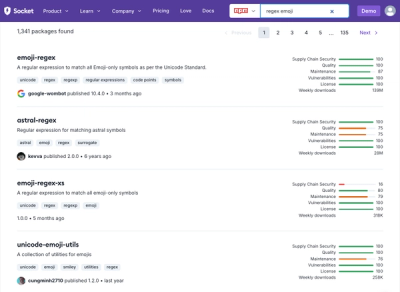
Research
Security News
Malicious npm Package Targets Solana Developers and Hijacks Funds
A malicious npm package targets Solana developers, rerouting funds in 2% of transactions to a hardcoded address.
react-navigation-header-buttons
Advanced tools
Easily render header buttons for react-navigation
This package will help you render buttons in the navigation bar and handle the styling, so you don't have to. It mimics the appearance of native navbar buttons and offers a simple but also flexible interface for you to interact with.
✅ DRY library api
✅ Works great with icons from @expo/vector-icons / react-native-vector-icons or any other icon library
✅ Supports Expo Router, and both JS and native stack
✅ Beautiful overflow menus for items that don't fit into the navbar
✅ Recipes and examples included
✅ Written in TS
✅ Test suite included (mostly good only for the maintainer, but hey, not bad to know it's there)
Contains many examples in the example folder. I highly recommend you check it out to get a better idea of the api.


The corresponding code:
import * as React from 'react';
import MaterialIcons from '@expo/vector-icons/MaterialIcons';
import {
HeaderButtons,
Item,
HiddenItem,
OverflowMenu,
Divider,
ItemProps,
HiddenItemProps,
HeaderButtonProps,
HeaderButton,
} from 'react-navigation-header-buttons';
import { Text } from 'react-native';
const MaterialHeaderButton = (props: HeaderButtonProps) => (
// the `props` here come from <Item ... />
// you may access them and pass something else to `HeaderButton` if you like
<HeaderButton IconComponent={MaterialIcons} iconSize={23} {...props} />
);
const EditItem = ({ onPress }: Pick<ItemProps, 'onPress'>) => {
return <Item title="edit" onPress={onPress} />;
};
const ReusableHiddenItem = ({ onPress }: Pick<HiddenItemProps, 'onPress'>) => (
<HiddenItem title="hidden2" onPress={onPress} disabled />
);
export function UsageWithIcons({ navigation }) {
React.useLayoutEffect(() => {
navigation.setOptions({
title: 'Demo',
headerRight: () => (
<HeaderButtons HeaderButtonComponent={MaterialHeaderButton}>
<Item
title="search"
iconName="search"
onPress={() => alert('search')}
/>
<EditItem onPress={() => alert('Edit')} />
<OverflowMenu
OverflowIcon={({ color }) => (
<MaterialIcons name="more-horiz" size={23} color={color} />
)}
>
<HiddenItem title="hidden1" onPress={() => alert('hidden1')} />
<Divider />
<ReusableHiddenItem onPress={() => alert('hidden2')} />
</OverflowMenu>
</HeaderButtons>
),
});
}, [navigation]);
return <Text>demo!</Text>;
}
HeaderButtonsIs a wrapper over all the visible header buttons (those can be text-buttons, icon-button, or any custom react elements).
You should provide the HeaderButtonComponent prop that encapsulates how all buttons rendered in children will look. Typically, you'll want to provide a component that wraps HeaderButton as seen in the example above. However, you're free to use your own component (see HeaderButton.tsx for reference).
In particular, it allows setting IconComponent, size and color in one place so that you don't need to repeat it for each icon-button - but you can override those for each Item if you like.
HeaderButtons accepts:
| prop and type | description | note |
|---|---|---|
HeaderButtonComponent?: ComponentType<HeaderButtonProps> | component that renders the buttons, HeaderButton by default | Typically, you'll want to provide a component that wraps HeaderButton provided by this package, as seen in the quick example. |
| children: ReactNode | whatever you want to render inside | Typically, Item or your component that renders Item, but it can be any React element. |
| left?: boolean | whether the HeaderButtons are on the left from header title | false by default, it only influences styling (margins) in a subtle way |
| preset?: 'tabHeader' | 'stackHeader' | headers are typically rendered in Stack Navigator, however, you can also render them in a Tab Navigator header. Pass 'tabHeader' if button margins are missing. | 'stackHeader' by default |
ItemRenders text, or icon inside a PlatformPressable. Take a look at the example above to see how to use it.
Item accepts:
| prop and type | description |
|---|---|
| title: string | title for the button, required |
| onPress: ?() => any | function to call on press |
| iconName?: string | icon name, used together with the IconComponent prop |
| style?: ViewStyle | style to apply to the touchable element that wraps the button |
| buttonStyle?: ViewStyle | style to apply to the text / icon |
| other props | whatever else you want to pass to the underlying PlatformPressable (eg. disabled) |
Item also accepts other props that you'll typically not need to pass because HeaderButtonComponent already knows them (eg. iconSize) or because they are pulled from the React Navigation's theme object (color).
| additional props and type | description | note |
|---|---|---|
| IconComponent?: ComponentType | component to use for the icons, for example from react-native-vector-icons | |
| iconSize?: number | icon size | |
| color?: string | color of icons and buttons | |
| renderButton?: (params: VisibleButtonProps) => ReactNode | renders the body of the button (text or icon), defaults to defaultRenderVisibleButton |
OverflowMenuDefines the behavior for overflow button (if there is one). You can render OverflowMenu only by itself too, you do not need to wrap it in HeaderButtons.
The most important prop is onPress which defines what kind of overflow menu we should show.
If OverflowMenu contains no valid child elements, nothing will be rendered at all. (No OverflowIcon, no wrapper.)
The package exports common handlers you can use, but you can provide your own too (via the onPress prop):
| exported handler | description |
|---|---|
defaultOnOverflowMenuPress | The default. Uses overflowMenuPressHandlerActionSheet on iOS, and overflowMenuPressHandlerDropdownMenu otherwise. |
overflowMenuPressHandlerActionSheet | This is iOS-only: it displays overflow items in an ActionSheetIOS |
overflowMenuPressHandlerPopupMenu | This is Android-only: it displays overflow items using UIManager.showPopupMenu |
overflowMenuPressHandlerDropdownMenu | Can be used on iOS, Android and Web. Displays overflow items in a material popup adapted from react-native-paper, credit for an amazing job goes to them. This Menu is bundled in this library (no dependency on react-native-paper) but only required if you actually use it. |
You can also use the react-native-menu to show the overflow menu, as seen in the example app.
OverflowMenu accepts:
| prop and type | description | note |
|---|---|---|
| OverflowIcon: ReactElement | ComponentType | React element or component for the overflow icon | if you provide a component, it will receive color prop as seen in example above |
| style?: ViewStyle | optional styles for overflow button | there are some default styles set, as seen in OverflowButton.tsx |
| onPress?: (OnOverflowMenuPressParams) => any | function that is called when overflow menu is pressed. | This will override the default handler. Note the default handler offers (limited) customization. See more in "Recipes". |
| testID?: string | testID to locate the overflow button in e2e tests | the default is available under import { OVERFLOW_BUTTON_TEST_ID } from 'react-navigation-header-buttons/e2e' |
| accessibilityLabel?: string | 'More options' by default | |
| left?: boolean | whether the OverflowMenu is on the left from header title | false by default, it just influences styling. No need to pass this if you already passed it to HeaderButtons. |
| children: ReactNode | the overflow items | typically HiddenItems, please read the note below |
| preset?: 'tabHeader' | 'stackHeader' | see props of headerbuttons | |
| other props | props passed to the nested PlatformPressable | pass eg. pressColor to control ripple color on Android |
[!NOTE] There are important limitations on what can be passed as children to
OverflowMenu:
Children passed to OverflowMenu should be
HiddenItemsHiddenItem, as seen in the example above.Anything else will be ignored and will not appear in the overflow menus shown by overflowMenuPressHandlerActionSheet and overflowMenuPressHandlerPopupMenu.
Only overflowMenuPressHandlerDropdownMenu supports rendering custom elements, such as <Divider /> (which is exported) or your custom ones.
This limitation may look weird, but it should not really bother you in any way: if you need to have state in your items, lift the state up.
The limitation exists because we need to be able to transform declarative React elements into imperative calls (ActionSheetIOS.showActionSheetWithOptions / UIManager.showPopupMenu).
If this is a problem for you for some reason, please raise an issue, and we'll see what can be done about it.
Please see UsageWithOverflowComplex.tsx for valid examples!
These will NOT work with overflowMenuPressHandlerActionSheet and overflowMenuPressHandlerPopupMenu:
function MyComponent({ title }) {
const [titleFromState, setTitle] = React.useState('from state hook');
return (
<HiddenItem title={titleFromState + title} onPress={() => alert('fail')} />
);
}
<OverflowMenu
OverflowIcon={<Ionicons name="ios-more" size={23} color="blue" />}
>
<MyComponent />
</OverflowMenu>;
HiddenItem only once, not twiceconst HiddenItemWrapped = () => <HiddenItem title="hidden2" onPress={() => alert('hidden2')} />;
const HiddenItemWrappedTwice = ()=> <HiddenItemWrapped />
<OverflowMenu OverflowIcon={<Ionicons name="ios-more" size={23} color="blue" />}>
<HiddenItemWrappedTwice />
</OverflowMenu>;
HiddenItemHiddenItem accepts:
| prop and type | description | note |
|---|---|---|
| title: string | title for the button, required | |
| style?: ViewStyle | style to apply to the touchable element that wraps the text | |
| titleStyle?: TextStyle | style to apply to the text | |
| onPress: ?() => any | function to call on press | |
| testID?: string | testID to locate view in e2e tests | |
| disabled?: boolean | disabled 'item' is greyed out and onPress is not called on touch | |
| destructive?: boolean | flag specifying whether this item is destructive | only applies to items shown with overflowMenuPressHandlerActionSheet |
HeaderButtonsProvider / HeaderButtonsProviderPlain / HeaderButtonsProviderDropdownMenuYou need to wrap your root component with a HeaderButtons Provider. stackType is a required prop, which indicates whether you're using a native or JS stack.
Importing: import { your_chosen_provider } from 'react-navigation-header-buttons/your_chosen_provider'.
There are 3 providers to choose from. Read more in Installation & Setup.
Optional spaceAboveMenu prop can be used to set the distance between the top of the screen and the top of the overflow menu when using overflowMenuPressHandlerDropdownMenu.
HeaderButtonHeaderButton is where all the onPress, title and Icon-related props (color, size) meet to render actual button.
You can fully customize what it renders inside of the PlatformPressable using the renderButton?: (params: VisibleButtonProps) => ReactNode prop.
overflowMenuPressHandlerDropdownMenu manuallyoverflowMenuPressHandlerDropdownMenu supports rendering custom items in the menu. In your item's onPress handler, you can call closeMenu to close the menu manually.
const { closeMenu } = useOverflowMenu();
The default handler for overflow menu on iOS is overflowMenuPressHandlerActionSheet.
One of the usual things you may want to do is override the cancel button label on iOS - see example.
You can also use the react-native-menu (or similar) to show the overflow menu, as seen in the example app.
Use the buttonStyle prop to set textTransform styles for button titles.
This sections covers how you should use the library in your project. Please note that there are numerous example screens.
1 . Define one file where the styling of header buttons is taken care of.
// MyHeaderButtons.js
import * as React from 'react';
import MaterialIcons from 'react-native-vector-icons/MaterialIcons';
import { HeaderButtons, HeaderButton } from 'react-navigation-header-buttons';
// define IconComponent, color, sizes and OverflowIcon in one place
const MaterialHeaderButton = (props) => (
<HeaderButton
IconComponent={MaterialIcons}
iconSize={23}
color="blue"
{...props}
/>
);
export const MaterialHeaderButtons = (props) => {
return (
<HeaderButtons HeaderButtonComponent={MaterialHeaderButton} {...props} />
);
};
2 . Import header buttons from the file defined previously.
// SomeScreen.js
import { MaterialHeaderButtons } from './MyHeaderButtons';
import { Item } from 'react-navigation-header-buttons';
React.useLayoutEffect(() => {
navigation.setOptions({
title: 'Demo',
// use MaterialHeaderButtons with consistent styling across your app
headerRight: () => (
<MaterialHeaderButtons>
<Item
title="add"
iconName="search"
onPress={() => console.warn('add')}
/>
<Item title="edit" onPress={() => console.warn('edit')} />
</MaterialHeaderButtons>
),
});
}, [navigation]);
Colors for Android ripple effect, text and icons come from React Navigation's theme, so you do not need to work with colors, except in OverflowIcon. You can always override colors of text&icons (using color prop) or of the ripple effect on Android (using pressColor prop) as documented.
FAQs
Easily render header buttons for react-navigation
The npm package react-navigation-header-buttons receives a total of 2,651 weekly downloads. As such, react-navigation-header-buttons popularity was classified as popular.
We found that react-navigation-header-buttons demonstrated a healthy version release cadence and project activity because the last version was released less than a year ago. It has 0 open source maintainers collaborating on the project.
Did you know?

Socket for GitHub automatically highlights issues in each pull request and monitors the health of all your open source dependencies. Discover the contents of your packages and block harmful activity before you install or update your dependencies.

Research
Security News
A malicious npm package targets Solana developers, rerouting funds in 2% of transactions to a hardcoded address.

Security News
Research
Socket researchers have discovered malicious npm packages targeting crypto developers, stealing credentials and wallet data using spyware delivered through typosquats of popular cryptographic libraries.

Security News
Socket's package search now displays weekly downloads for npm packages, helping developers quickly assess popularity and make more informed decisions.